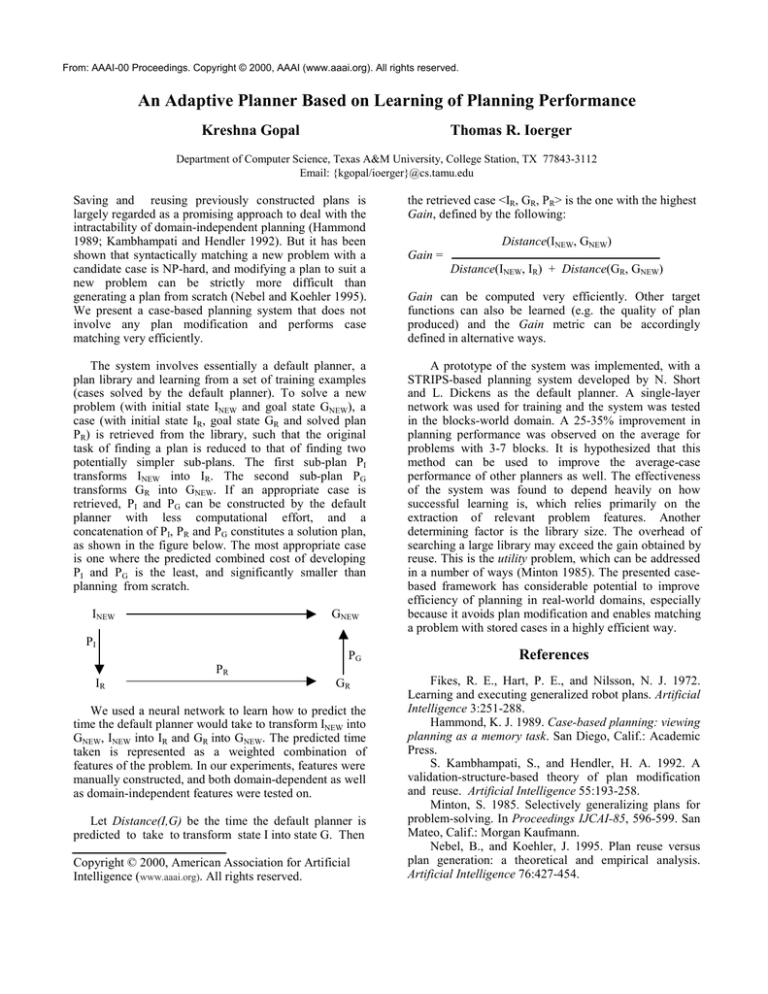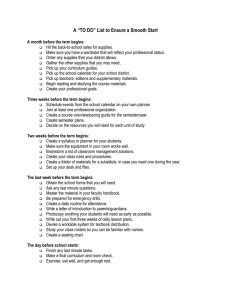
From: AAAI-00 Proceedings. Copyright © 2000, AAAI (www.aaai.org). All rights reserved.
An Adaptive Planner Based on Learning of Planning Performance
Kreshna Gopal
Thomas R. Ioerger
Department of Computer Science, Texas A&M University, College Station, TX 77843-3112
Email: {kgopal/ioerger}@cs.tamu.edu
Saving and reusing previously constructed plans is
largely regarded as a promising approach to deal with the
intractability of domain-independent planning (Hammond
1989; Kambhampati and Hendler 1992). But it has been
shown that syntactically matching a new problem with a
candidate case is NP-hard, and modifying a plan to suit a
new problem can be strictly more difficult than
generating a plan from scratch (Nebel and Koehler 1995).
We present a case-based planning system that does not
involve any plan modification and performs case
matching very efficiently.
the retrieved case <IR, GR, PR> is the one with the highest
Gain, defined by the following:
The system involves essentially a default planner, a
plan library and learning from a set of training examples
(cases solved by the default planner). To solve a new
problem (with initial state INEW and goal state GNEW), a
case (with initial state IR, goal state GR and solved plan
PR) is retrieved from the library, such that the original
task of finding a plan is reduced to that of finding two
potentially simpler sub-plans. The first sub-plan PI
transforms INEW into IR. The second sub-plan PG
transforms GR into GNEW. If an appropriate case is
retrieved, PI and PG can be constructed by the default
planner with less computational effort, and a
concatenation of PI, PR and PG constitutes a solution plan,
as shown in the figure below. The most appropriate case
is one where the predicted combined cost of developing
PI and PG is the least, and significantly smaller than
planning from scratch.
A prototype of the system was implemented, with a
STRIPS-based planning system developed by N. Short
and L. Dickens as the default planner. A single-layer
network was used for training and the system was tested
in the blocks-world domain. A 25-35% improvement in
planning performance was observed on the average for
problems with 3-7 blocks. It is hypothesized that this
method can be used to improve the average-case
performance of other planners as well. The effectiveness
of the system was found to depend heavily on how
successful learning is, which relies primarily on the
extraction of relevant problem features. Another
determining factor is the library size. The overhead of
searching a large library may exceed the gain obtained by
reuse. This is the utility problem, which can be addressed
in a number of ways (Minton 1985). The presented casebased framework has considerable potential to improve
efficiency of planning in real-world domains, especially
because it avoids plan modification and enables matching
a problem with stored cases in a highly efficient way.
INEW
GNEW
PI
PG
PR
IR
GR
We used a neural network to learn how to predict the
time the default planner would take to transform INEW into
GNEW, INEW into IR and GR into GNEW. The predicted time
taken is represented as a weighted combination of
features of the problem. In our experiments, features were
manually constructed, and both domain-dependent as well
as domain-independent features were tested on.
Let Distance(I,G) be the time the default planner is
predicted to take to transform state I into state G. Then
Copyright © 2000, American Association for Artificial
Intelligence (www.aaai.org). All rights reserved.
Distance(INEW, GNEW)
Gain =
Distance(INEW, IR) + Distance(GR, GNEW)
Gain can be computed very efficiently. Other target
functions can also be learned (e.g. the quality of plan
produced) and the Gain metric can be accordingly
defined in alternative ways.
References
Fikes, R. E., Hart, P. E., and Nilsson, N. J. 1972.
Learning and executing generalized robot plans. Artificial
Intelligence 3:251-288.
Hammond, K. J. 1989. Case-based planning: viewing
planning as a memory task. San Diego, Calif.: Academic
Press.
S. Kambhampati, S., and Hendler, H. A. 1992. A
validation-structure-based theory of plan modification
and reuse. Artificial Intelligence 55:193-258.
Minton, S. 1985. Selectively generalizing plans for
problem-solving. In Proceedings IJCAI-85, 596-599. San
Mateo, Calif.: Morgan Kaufmann.
Nebel, B., and Koehler, J. 1995. Plan reuse versus
plan generation: a theoretical and empirical analysis.
Artificial Intelligence 76:427-454.



